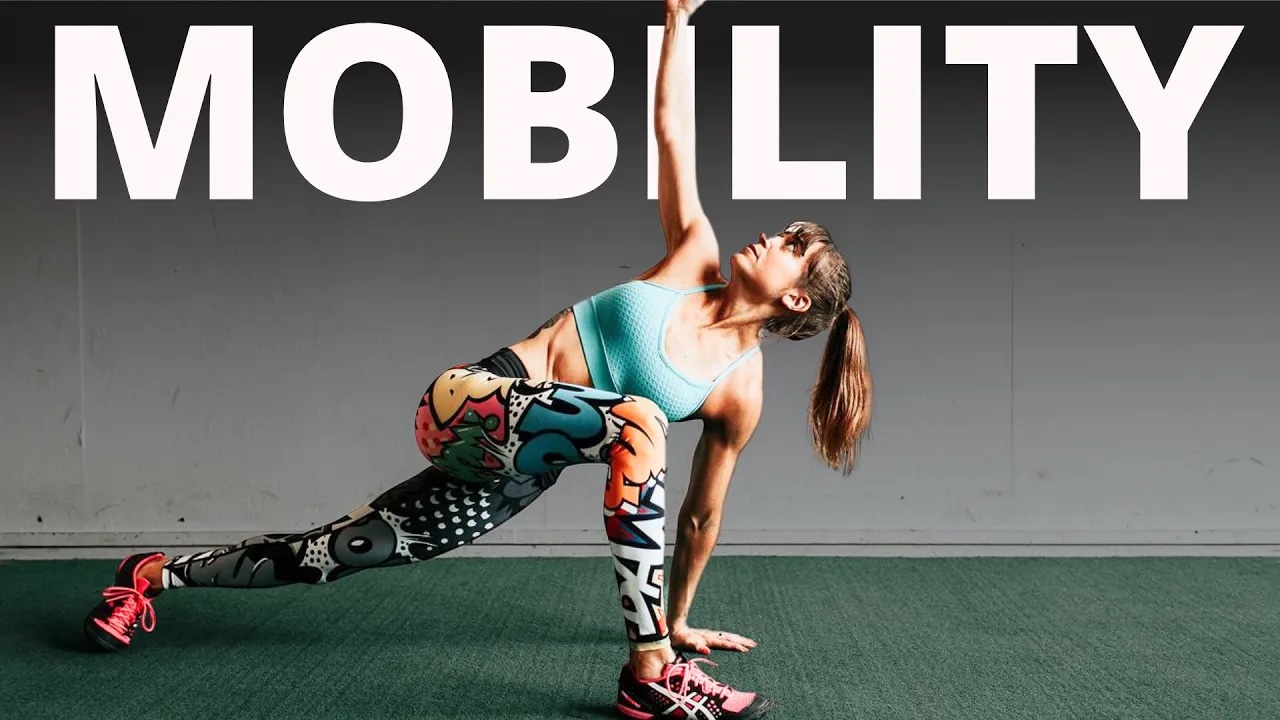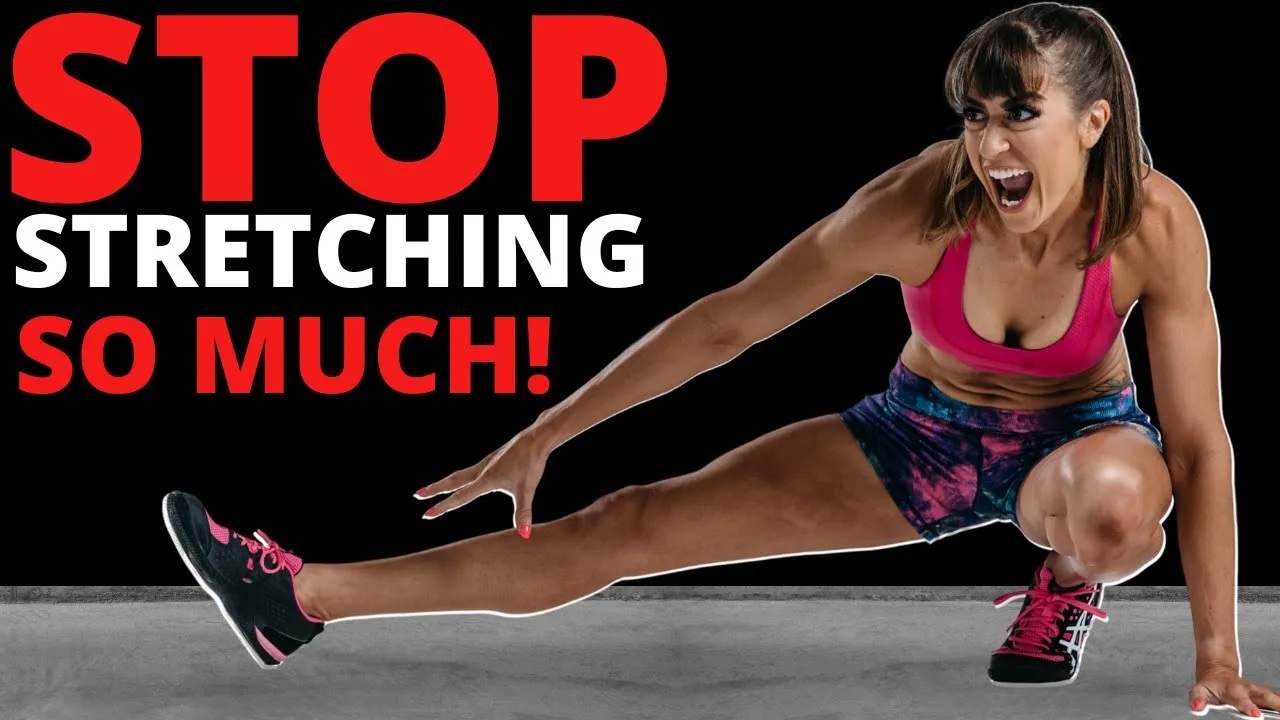
10 Mobility Lessons I Wish I Knew Sooner
I’ve made a TON of mistakes.
Made excuses to skip my warm ups that lead to overload and injury.
Slacked on my mobility work, which led to improper recruitment patterns and pain.
Ignored aches and pains until it was too late and I couldn’t train the way I wanted…
I’ve learned far too many lessons the hard way…
But I want to help you avoid the same frustrations and pain…
That’s why I’m going to share 10 key mobility lessons I’ve learned to help you avoid making the same mistakes and move and feel your best no matter your age!
Because so often what we even blame on our age is simply previous aches and pains and training practices coming back to bite us in the butt!
Sooo the first mobility lesson I wish I’d known sooner was…

#1: It’s Not Just About Form.
I’d always prided myself on having good form.
But good form doesn’t mean you’re always using the correct muscles.
Actually mimicking proper form may be leading to you overusing muscles not meant to carry the load and seeking out mobility from joints that aren’t really meant to provide that range of motion.
The more advanced we are too, the more we know how a move SHOULD look so we force that movement pattern, using whatever is needed.
And this can result in overload and injury just as much, if not sometimes even MORE than improper form.
Because we’re forcing a movement we can’t actually perform properly!
So focus not just on form and how the movement looks but your recruitment pattern and what you feel working!
If you can’t feel the correct muscles working, you haven’t earned that movement.
Instead you need to regress to then build up or you need to swap to a different variation you can perform properly as you address the underlying mobility restrictions and muscle weakness!
#2: The Point Of “Pain” Isn’t Always Where The Problem Started.
When we end up with a shoulder injury, we blame our shoulder.
Back pain, we blame our back. Often we even think, “Oh this area is injured because it was weak.” And then we overwork the muscle further trying to rehab it.
But this only perpetuates the issue.
Because often injury occurs due to overload.
Our back becomes overworked because our glutes or abs are weak or not being used efficiently during movements.
Or a lack of thoracic extension leads to us seeking out mobility and stability from our shoulder during the overhead press that it isn’t meant or able to provide.
Issues elsewhere lead to the injuries.
Often where the pain is isn’t where the problem started.
And this is why, when we are addressing aches and pains we can’t get so focused on the aches and pains only.
We need to assess movements and how joints and muscles are working together.
Because limitations in mobility or instability at one joint, say your ankles, can impact your movements all the way up your body, resulting in overload and injury.
That ankle injury from years ago, may now be why you have knee pain!
This is also why resting a previous injury isn’t enough.
Which is actually the next big lesson I learned…
#3: Resting An Injury Doesn’t Make It Go Away.
When we have aches and pains or injuries, we first turn to rest to help the pain go away.
While resting an area can be a key first step in recovery, it doesn’t change why the overload occurred in the first place.
So if you just take time off till something feels better then go back to training as you were, you may just end up injured again.
You haven’t taken time to address where the mobility restriction was. Or what muscle was weak and led to overload.
You haven’t changed your form or your recruitment patterns.
And if you don’t address what led to the injury and overload, often you’re just going to end up injured again from doing the same things.
Now you may be thinking, “But I’ll just avoid those movements.”
But this isn’t really a long-term solution.
So many of those movements we do in everyday life.
And at some point, that weakness or mobility issue is going to pop back up.
Instead of just resting, we need to take things back to basics and include the prehab work needed to truly address what added up in the first place.
This can help us from falling prey to this injury becoming chronic so we can consistently train the way we want to see results!
Which is why you need to see prehab as a 3-part process.
And this is lesson #4, which has been the biggest game changer for me so that I haven’t had another injury sideline me and I’ve been able to nip aches and pains before they add up…
#4: Prehab is a 3-Part process.
Addressing an ache or pain means not only relaxing overactive muscles, but improving your joint mobility and even activating underactive muscles to improve stability.
There are multiple components to making sure muscles are working as they should be and joints have the proper range of motion.
Not to mention, the longer we’ve potentially ignored an issue, the more that has built up as we’ve compensated.
It’s why the process of foam rolling, stretching and activation was the biggest game changer for me and I’ve seen it have the biggest impact on my clients functional fitness as well.
It’s why I even had a client say to me “I’m moving better now than I did in my 20s and 30s!”
None of these components alone have the same impact.
The system as a whole is what makes each part so effective.
The foam rolling helps relax overactive muscles we may even tend to overuse.
The stretching, especially dynamic stretching used prior to a workout, helps mobilize our joints and return muscles to their proper length-tension relationships.
The activation then continues to help mobilize joints, stretching muscles through a process called reciprocal inhibition as it works to activate underactive muscles. This activation helps improve our mind-body connection to better use these muscles to carry the loads they should when we train and move.
This process works together to help address all components needed to avoid us perpetuating the overuse, overload and injury!
But even as game changing as this process really was for me and as much as I credit this with even helping me be able to lift more…
You can’t out mobility work your other movements.
Your workouts have to complement the mobility work you’re doing.
Lesson #5: Strengthen Through A Full Range Of Motion.
You’ve done that prehab work to be able to move through a full range of motion and use the correct muscles…
But if you don’t now do the work to actually strengthen the muscles through the range of motion you’ve prepped your body to be able to handle, you won’t maintain it.
If you lift and do half squats after working on your hip mobility, you’re going to only have stability and strength through that smaller range of motion. And you’re going to tighten things back up.
So basically it’s going to feel like all of your mobility work isn’t adding up and is a waste.
But it isn’t.
Instead, you have to check your ego, and use lighter weights to move through the full range of motion you’ve established with the 3-part prehab process.
But it’s key that we do adjust the range of motion of exercises to build strength through the range of motion we want!
Now…The next big lesson I learned was oddly a mindset shift….and something I think we too often just ignore…
And it has to do with IMBALANCES.
Every notice one side is weaker? Or that you have stronger muscles around a joint causing restrictions?
#6: Well, Those Imbalances Are Worse Than Inflexibility.
Feel like the tin man over gumbi?
Honestly just being inflexible, while something you may want to work on isn’t as bad as we often make it out to be.
If everything is tight, you’re at least EVEN in how you can move.
It’s less of an issue if you can’t touch your toes than if you can’t touch your toes but you can do the side splits.
This imbalance of muscle flexibility around a joint can lead to overload and injury as you have more movement and potentially less stability in one plane of motion.
It’s why you may need to do imbalance prehab work to address the issues, relaxing only specific muscles while activating others.
It’s why you may need to pay attention to including movements in specific planes of motion and even working specific muscles more!
And it’s not just discrepancies around a single joint that we need to pay attention to but imbalances between sides.
If one side is mobile and the other isn’t? If one side is stronger?
This can lead to overload of the stronger side when the weaker side can’t keep up.
Or it can lead to the weaker side becoming overworked and muscles compensating as it tries to keep up with your dominant side.
Imbalances need to be addressed.
Whether it is holding back our stronger side, doing more reps using rest pause technique on the weaker side or even ONLY including unilateral moves so the stronger side can’t take over, we need to make sure we’re addressing those imbalances.
#7: Flexibility And Mobility Depend On Stability.
Ever move a joint through a bigger range of motion and then go to lift and find you can’t really move through even half of what you had been able to do with your own bodyweight?
This may be an issue with stability!
Far too often the emphasis is put on flexibility and mobility…
We talk about stretching and mobilizing joints to improve our range of motion and squat deeper or press overhead properly.
But part of what allows a joint to move through that full range of motion as we correctly recruit muscles to power the movement is STABILITY.
If a joint doesn’t feel stable, your mind is going to restrict the range of motion you can work through.
So if muscles aren’t strong enough, the joint movement may be limited or your active flexibility may seem a lot smaller than what you’re able to do in a static or passive position.
And too often we ignore this signal and push through with heavier loads anyway.
This is then what leads to aches and pains and us seeking out strength from muscles not meant to carry the load or a range of motion from a joint not meant to provide it.
This is why that activation component or even some lighter load work and isometrics…the stuff that doesn’t seem as sexy or hard, may be so key!
We also don’t want to ignore this instability because it may hint that we actually aren’t properly addressing muscle tightness as well…
#8: A Tight Muscle Doesn’t Always Need To Be Stretch.
Pull a rubber band and stretch it out and it’s going to feel tight.
Decide to stretch it further because it feels tight and you’re going to snap it.
Muscles don’t just feel tight when they’re shorten.
They can also feel tight because they are overstretched.
This is why paying attention to joint stability and even lesson number 2 (that the point of pain isn’t always where the problem is) is so key.
Everything is connected.
So we need to assess overall postures and movements to really see what is going on over just honing in and looking at a muscle in isolation at times.
Our hamstrings are a prime example of this.
Too often they are tight from being overstretched due to tight hip flexors from sitting so much.
This daily posture can make us feel like we need to stretch our hamstrings, when actually it is our hip flexors that are shortened and in need of stretching.
And due to them being overly lengthened and this overall posture, our hamstrings may also be overworked.
This can create instability at our hip and even our knee, leading to more issues and not just putting our hamstrings at risk for being pulled.
And if we were to just say “My hamstrings feel tight” and stretch them more?
We may even be making matters worse.
It’s why we need to truly look at how muscles and joints function together and our overall movement and recruitment patterns.
Too often we don’t ask ourselves, “What do I feel working?”
Because if we did, we may notice our hamstrings compensating in moves for our glutes only further perpetuating the feeling of tightness!
And if you’re thinking, “But I don’t have time to address all these things…”
#9: 5-Minutes Is All You Need.
So often we don’t do anything because we feel we can’t do enough.
But if we can just commit to 5 minutes a day of mobility work and do that daily, that time will not only add up but the daily consistency will help results build.
This is why you need to stop skipping your warm up!
Which is actually what I was originally going to call this lesson.
But even when it relates to your warm up, you don’t need 15 minutes or a ton of time to prep your body.
That prehab process can be used efficiently to mobilize and activate what you plan to work that day!
Doing a little each day to grease the wheel pays off over letting things add up so you have to peel back each layer that’s built up.
So stop stressing about doing full recovery sessions more frequently even. Just focus on 5 minutes, even if that 5 minutes is an intentional warm up that you don’t skip!
You’ll be surprised by how even that warm up helps you move better in your workouts to get more out of each session and strengthen through that full range of motion to actually make your mobility work add up even more!
Which leads me to biggest and most important lesson of all…
#10: Rehab becomes Prehab.
Let’s face it…many of us have had aches and pains and injuries in the past.
Things that are “better” now…
So we get lazy about continuing to work on our areas of weakness. And then when we least expect it, aches and pains rear their ugly heads.
This leads to us feeling frustrated that we can’t ever fully seem to get momentum with things.
But this is why rehab becomes prehab.
What we did to make things “better” needs to be done proactively to keep things working well.
Otherwise we default back into old recruitment and movement patterns.
So instead of having to spend a ton of time being reactive or not training the way we want, keep in that mobility work as part of your warm up.
And if you do notice things popping up, don’t be afraid to step back and address those weak links.
Honestly, with all of these lessons, it’s really about being aware and being intentional in our training so we can address things before they really add up!
The more aware we are of how our body is feeling and our movements, the more we can modify and progress as we need to keep training consistently while feeling and moving our best!
Ready for workouts that have the prehab work done for you?



